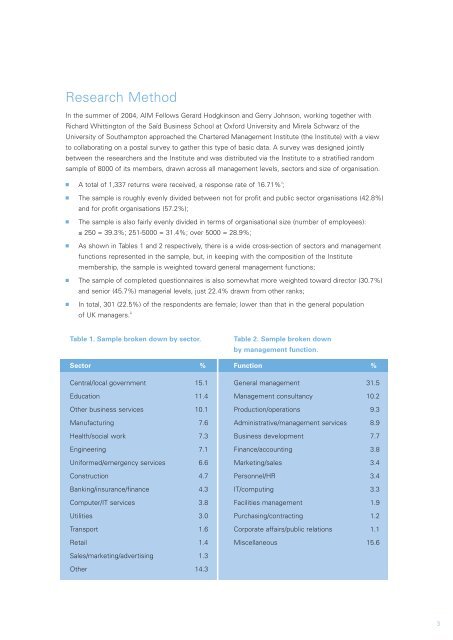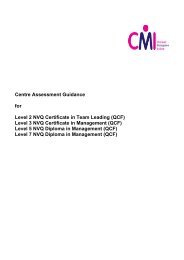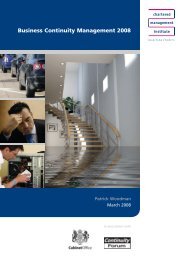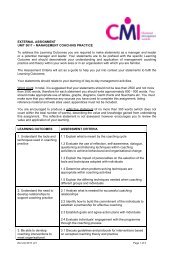The Role and Importance of Strategy Workshops - (AIM) Research
The Role and Importance of Strategy Workshops - (AIM) Research
The Role and Importance of Strategy Workshops - (AIM) Research
Create successful ePaper yourself
Turn your PDF publications into a flip-book with our unique Google optimized e-Paper software.
<strong>Research</strong> MethodIn the summer <strong>of</strong> 2004, <strong>AIM</strong> Fellows Gerard Hodgkinson <strong>and</strong> Gerry Johnson, working together withRichard Whittington <strong>of</strong> the Saïd Business School at Oxford University <strong>and</strong> Mirela Schwarz <strong>of</strong> theUniversity <strong>of</strong> Southampton approached the Chartered Management Institute (the Institute) with a viewto collaborating on a postal survey to gather this type <strong>of</strong> basic data. A survey was designed jointlybetween the researchers <strong>and</strong> the Institute <strong>and</strong> was distributed via the Institute to a stratified r<strong>and</strong>omsample <strong>of</strong> 8000 <strong>of</strong> its members, drawn across all management levels, sectors <strong>and</strong> size <strong>of</strong> organisation.■ A total <strong>of</strong> 1,337 returns were received, a response rate <strong>of</strong> 16.71% ii ;■ <strong>The</strong> sample is roughly evenly divided between not for pr<strong>of</strong>it <strong>and</strong> public sector organisations (42.8%)<strong>and</strong> for pr<strong>of</strong>it organisations (57.2%);■■<strong>The</strong> sample is also fairly evenly divided in terms <strong>of</strong> organisational size (number <strong>of</strong> employees):≤ 250 = 39.3%; 251-5000 = 31.4%; over 5000 = 28.9%;As shown in Tables 1 <strong>and</strong> 2 respectively, there is a wide cross-section <strong>of</strong> sectors <strong>and</strong> managementfunctions represented in the sample, but, in keeping with the composition <strong>of</strong> the Institutemembership, the sample is weighted toward general management functions;■ <strong>The</strong> sample <strong>of</strong> completed questionnaires is also somewhat more weighted toward director (30.7%)<strong>and</strong> senior (45.7%) managerial levels, just 22.4% drawn from other ranks;■In total, 301 (22.5%) <strong>of</strong> the respondents are female; lower than that in the general population<strong>of</strong> UK managers. iiiTable 1. Sample broken down by sector.Table 2. Sample broken downby management function.Sector % Function %Central/local government 15.1 General management 31.5Education 11.4 Management consultancy 10.2Other business services 10.1 Production/operations 9.3Manufacturing 7.6 Administrative/management services 8.9Health/social work 7.3 Business development 7.7Engineering 7.1 Finance/accounting 3.8Uniformed/emergency services 6.6 Marketing/sales 3.4Construction 4.7 Personnel/HR 3.4Banking/insurance/finance 4.3 IT/computing 3.3Computer/IT services 3.8 Facilities management 1.9Utilities 3.0 Purchasing/contracting 1.2Transport 1.6 Corporate affairs/public relations 1.1Retail 1.4 Miscellaneous 15.6Sales/marketing/advertising 1.3Other 14.33
















